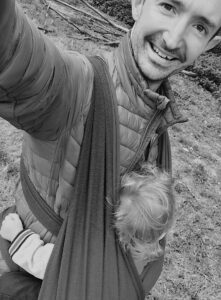
Becoming a new parent is an exciting and overwhelming experience, especially when it comes to taking care of a newborn. One of the best ways to keep your little one close and comforted is through babywearing. Babywearing is the practice of using various types of carriers to hold your baby on your body. This technique has been around for centuries and has gained popularity in recent years due to its benefits for both the parent and the baby. In this article, we will discuss the benefits of babywearing, different types of carriers, and guidelines to follow to ensure safe and comfortable babywearing.
Developing and nurturing the physical contact and bond between a mother who is breastfeeding and her baby, as well as the partner or caregiver and the newborn, is extremely important and fulfilling. Although there are numerous baby carriers available on the market, proper positioning is crucial to prevent potential damage to the mother’s spine and the baby’s hips and pelvis.
By the way, if you are currently pregnant and would like to know more about the benefits of Chiropractic care, you can read our article about Chiropractic care during pregnancy here.
Some important tips to keep in mind:
- 👶 The baby should be visible and kissable (when in front of parent)
- 👶 The baby should be upright, facing the carrier and not facing away
- 👶 The base of the carrier should go knee-to-knee, keeping the knees above the hips
- 👶 The head should be supported, especially for the first 4 months
- 👶 The support should extend up to the height of the bottom of the ears; too high an it might compromise breathing/ventilation, and too low simply will not provide sufficient support
- 👶 The baby should be able to sit unassisted before they are to be carried on the back
- 👶 Consider transitioning to back carrying as soon as reasonably possible. This way the baby can see better, and the carrier will experience better ergonomics
Features/characteristics of carriers you should avoid:
- 👶 One where you carry the baby on your side
- 👶 A carrier where only the bum is supported while the thighs hang down from the hips
- 👶 A carrier that has a hard supporting peice forcing the baby’s body into a fixed position
- 👶 Facing the baby away from the carrier (i.e. forwards)
- 👶 This not only limits intimate contact between carrier and the baby, but it exposes the baby to too much environmental stimuli.
- 👶 Front facing carriers also offer poorer support to the pelvis/hips/legs
- 👶 Insufficient support for the head/neck
It is important to take into account the impact of carriers on the wearer. Many people who wear carriers may experience uncomfortable arching of the lower back, and/or tension in the upper back, neck and shoulders. Ensuring proper engagement or bracing of the core muscles is crucial when wearing these carriers. This can be particularly challenging for new moms whose muscle strength and balance in the central part of their bodies are likely to be weak due to the pregnancy and birthing process.
Some carries worth considering:
Ring Slings
A baby sling is a long, woven fabric with two rings on the end. To lock it, you pass the free end through and back through the rings, creating a comfortable, upright seat for the baby to face the parent. You can use it from birth until the baby is no longer willing to be carried. Although it’s fast and convenient, it takes some practice to get the baby in the best position. The sling is similar to a messenger bag and can put more weight on one shoulder than the other.
Moby/K’tan
These are stretchy fabrics that are used from birth up until the baby is about 6-7kg. After this point, the fabric may stretch too much, which can become unsafe for the baby. The Moby wrap is made from one long piece of fabric, which may be intimidating to use and can be uncomfortable in warm climates. The K’tan wrap comes in preset sizes, so it may not fit well for different parents to share. However, these wraps are affordable and provide an easy start to babywearing.
Mei-Dai
A meh dai is a type of Asian carrier that was first developed in China many years ago. It consists of a fabric panel with long straps that are wound around the parent’s body and then tied, twisted, or tucked away securely to create a comfortable and secure hold. The carrier has two straps at the base that are tied or buckled around the waist, and two straps at the top of the panel that can be wrapped around the parent and baby to ensure a snug fit. The straps can be tightened and adjusted to fit the body exactly, which can be more challenging with buckle carriers that are limited by the placement of buckles or the length of webbing.
The examples mentioned above are just some of the carriers that are available in the market. It is recommended to try out different types and brands of carriers. However, please keep in mind two essential features that a baby carrier must have. Firstly, the base of support should be wide enough to go from knee-to-knee, with the knees positioned higher than the hips. Secondly, the baby’s head should be supported, particularly in the first four months or until they develop proper independent head and neck control.
In conclusion, babywearing is an excellent way to bond with your baby while keeping them safe and secure. By following the guidelines mentioned above and choosing the right carrier, you can make the most of your up-close and personal bonding time with your little one. Remember, this time with your baby is precious and goes by quickly, so enjoy it while it lasts!



